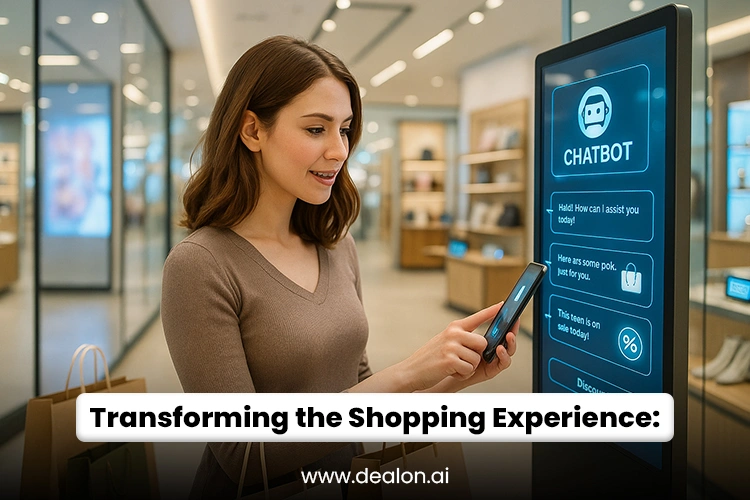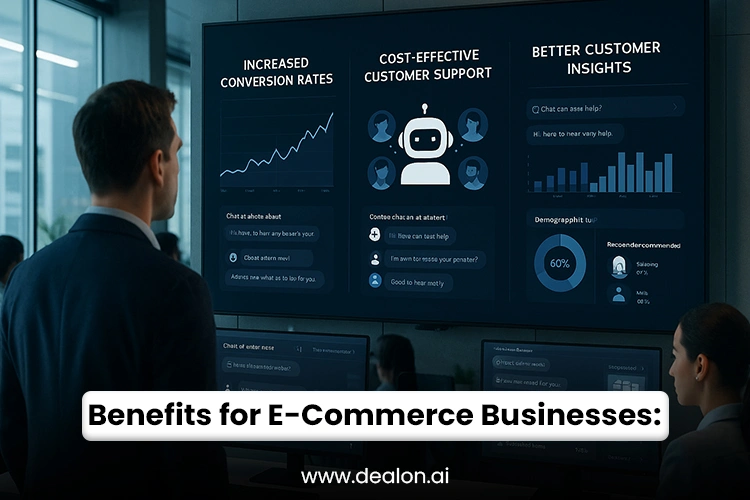In the dynamic and fiercely competitive realm of e-commerce, businesses increasingly turn to innovative technologies to elevate the customer experience and drive conversions. Integrating chatbots as personal shoppers has emerged as a game-changer among these groundbreaking advancements. These sophisticated AI-driven assistants transform online shopping by providing instant, personalized guidance tailored to consumers’ preferences and purchasing behavior. Unlike traditional e-commerce interfaces, where customers often navigate an impersonal sea of products, chatbots engage in dynamic, real-time conversations that simulate the expertise of a personal shopper.
By analyzing vast amounts of consumer data, chatbots can offer bespoke recommendations, suggest complementary products, and even anticipate demands before they are explicitly stated, creating an intuitive and seamless shopping experience. This intelligent automation expedites decision-making and enhances customer satisfaction, fostering a more profound connection between brands and their audiences. As AI continues to evolve, chatbots are poised to play an increasingly central role in the future of online retail.
Also Read: 7 Creative Ways AI is Used in Crafting Compelling Brand Narratives
The Rise of AI in E-Commerce

The rise of AI in e-commerce marks a transformation in how businesses interact with customers. As digital marketplaces become increasingly saturated and consumer expectations evolve, companies are under more pressure to provide tailored, frictionless shopping experiences. Traditional e-commerce approaches, such as static websites and generic product recommendations, no longer engage today’s discerning shoppers. The introduction of AI-powered chatbots, however, offers a sophisticated solution to these challenges, enhancing both customer satisfaction and operational efficiency.
Chatbots in e-commerce harness advanced artificial intelligence (AI) and machine learning (ML) algorithms to analyze consumer behavior, preferences, and historical data. By doing so, these intelligent systems can engage in real-time conversations, delivering highly personalized shopping experiences that mirror the assistance one might receive from a human salesperson. Whether customers are browsing for a specific product, seeking recommendations based on past purchases, or simply requiring assistance with site navigation, AI-driven chatbots can provide instant, accurate responses.
Moreover, these chatbots are not just reactive tools; they anticipate customer needs and proactively suggest relevant products based on real-time interactions. This predictive capability is a game-changer in e-commerce, transforming the shopping experience into an intuitive journey rather than a transactional process. For example, suppose a customer expresses interest in a particular item. In that case, a chatbot can immediately offer complementary products or alert them to ongoing promotions, effectively increasing the likelihood of upselling or cross-selling.
Additionally, chatbots can streamline the checkout process, guiding customers through each step and ensuring a smooth transaction. By automating many customer service functions, e-commerce businesses can decrease the necessity for human intervention, permitting greater scalability and cost efficiency. In this way, AI enhances the customer experience and drives business growth through increased engagement, higher conversion rates, and reduced operational costs.
How Chatbots Are Transforming the Shopping Experience

In today’s fiercely competitive e-commerce landscape, businesses harness advanced technologies to stay ahead and elevate the shopping experience. Among the most transformative innovations are AI-powered chatbots, redefining how customers engage with online stores. By offering personalized guidance and streamlining the purchase process, chatbots are reshaping e-commerce in profound ways.
Gone are the days of impersonal, generic product suggestions. Today, chatbots in e-commerce utilize sophisticated algorithms powered by big data analytics to offer highly personalized product recommendations. By analyzing extensive quantities of customer data, such as previous purchases, browsing behavior, and even seasonal trends, chatbots can tailor their suggestions to individual preferences. This means that when a customer interacts with a chatbot, they aren’t simply being presented with a random assortment of items—they’re receiving curated recommendations that feel intuitive and relevant.
Moreover, these bots can engage in dynamic, real-time conversations, asking customers thoughtful questions to refine their suggestions further. For example, a customer browsing for a gift might be asked about the recipient’s age, interests, or preferred color schemes, ensuring that the recommendations perfectly align with their needs.
One of the standout features of chatbots is their capacity to provide uninterrupted service 24 hours a day, 7 days a week. In the global world of e-commerce, customers can be spread across various time zones, and their needs can arise at any moment. Chatbots ensure that no matter when a customer visits a website, they will receive immediate assistance. Whether it’s answering questions about product features, helping with delivery timelines, or clarifying return policies, these bots are always ready to respond.
This level of availability eliminates frustrating delays and empowers customers to make purchasing decisions without waiting for business hours or an available representative. By offering rapid, efficient responses, chatbots ensure a smoother, hassle-free shopping experience that meets the expectations of today’s fast-paced digital consumers.
For many online shoppers, checkout is critical in the buying journey. Chatbots streamline this experience by guiding customers through every step of the checkout process. These AI assistants can proactively suggest complementary items, upsell relevant products, and ensure customers know about ongoing promotions or discounts.
Additionally, chatbots can simplify payment processing by integrating with secure payment systems, allowing customers to complete transactions quickly and efficiently. Chatbots improve customer satisfaction and boost the odds of conversions by reducing friction in the final stages of the purchase process.
Modern chatbots stand out from earlier versions thanks to their ability to hold smooth, human-like conversations that feel natural and intuitive. Powered by advanced NLP algorithms, these bots can understand complex customer queries and respond in authentic and conversational ways. This sophisticated form of communication helps customers feel more at ease and creates an interaction that closely mirrors the experience of speaking to a knowledgeable personal shopper.
Whether a customer is seeking advice on which product best suits their needs, looking for style recommendations, or needing help finding a specific item, the chatbot responds with a tone and style that is both engaging and informative. This naturalistic approach to conversation builds trust and improves the shopping experience, promoting a deeper connection between customers and brands.
Benefits for E-Commerce Businesses: Leveraging Chatbots as Personal Shoppers

Integrating AI-powered chatbots as personal shoppers within e-commerce platforms revolutionizes how businesses interact with customers. By providing personalized, real-time assistance, these chatbots offer businesses many advantages beyond simply improving the customer experience. By strategically deploying chatbots, e-commerce companies can streamline operations, enhance scalability, boost conversion rates, and achieve an advantage in the evolving marketplace.
Increased Conversion Rates
A key benefit of utilizing chatbots in e-commerce is the substantial increase in conversion rates. Chatbots excel in offering personalized product recommendations, which help guide customers toward the right purchases, ultimately boosting their confidence in the decision-making process. Customers who feel well-supported and well-informed are far more likely to complete transactions. Additionally, chatbots are critical in reducing cart abandonment, one of the most significant challenges in online retail. By providing immediate assistance during the checkout process—whether it’s clarifying doubts about shipping policies, offering discounts, or suggesting complementary products—chatbots can mitigate common pain points that often cause customers to abandon their carts. This seamless support translates to higher completion rates and more excellent business sales.
Cost-Effective Customer Support
Customer support is vital but can be costly and resource-intensive for e-commerce businesses. With the advent of chatbots, many customer service functions human agents previously handled can now be automated. These bots are adept at answering frequently asked questions, offering product guidance, troubleshooting common issues, and assisting with returns or exchanges. By automating these routine tasks, businesses can significantly reduce the need for large customer service teams, thus lowering operational costs. This cost-saving advantage allows businesses to reallocate resources into other areas, such as marketing or product development, further contributing to overall growth.
Better Customer Insights
Chatbots are not just interactive tools; they are data goldmines for businesses. Each interaction with a chatbot generates valuable insights into customer preferences, behaviors, and pain points. For instance, bots can track which products customers frequently inquire about, what features they value most, and where they tend to hesitate during their buying journey. By analyzing this data, businesses can fine-tune their marketing strategies, improve their product offerings, and identify emerging trends. This data-driven approach allows e-commerce businesses to stay ahead of the curve and better align their strategy with evolving customer needs, enhancing customer satisfaction and loyalty.
Scalability and Flexibility
As e-commerce businesses scale, the ability to manage increasing customer interactions becomes a significant challenge. Chatbots offer unparalleled scalability, allowing businesses to handle thousands of interactions simultaneously without compromising quality. Unlike human agents, who are constrained by time and resources, chatbots can efficiently assist customers 24/7, across various time zones, and even during high-traffic periods. This flexibility is essential for businesses looking to grow rapidly, as chatbots can support a more extensive customer base without requiring proportional increases in staffing. The ability to scale efficiently ensures that companies maintain high-quality customer service even as they expand their operations.
Overcoming Challenges: Ensuring a Seamless Chatbot Experience
While AI-powered chatbots are reshaping the e-commerce landscape, businesses must consider several challenges to ensure these virtual assistants contribute positively to the customer journey. Chatbots provide unparalleled convenience but should not replace the essential human touch in all scenarios. To create an optimal chatbot experience, businesses must balance automation with personalized human interactions, ensuring smooth transitions and consistent performance.
Balancing Automation with Human Interaction
Despite the sophistication of modern AI, chatbots can struggle to handle complex or emotionally charged situations. Customers facing intricate issues—such as troubleshooting faulty products, resolving billing disputes, or navigating high-value purchases—may feel frustrated by an AI lacking a human agent’s nuance and empathy. In these cases, the lack of human intervention could hinder trust and ultimately affect brand loyalty.
To overcome this, businesses must ensure that chatbot systems have seamless handoff capabilities. When a customer’s query reaches the limits of the bot’s functionality, the system should automatically escalate the conversation to a live agent without causing delays or requiring the customer to repeat information. This smooth transition between chatbot and human assistance ensures that customers feel heard and supported, regardless of the complexity of their needs. Additionally, offering the option for customers to request human aid at any point in the conversation builds trust and enhances the user experience.
Continuous Optimization and Evaluation
To provide an exceptional and ever-evolving customer experience, businesses must regularly evaluate and optimize their chatbot performance. AI models that power chatbots require continuous training to stay relevant, accurate, and effective. This can involve monitoring customer interactions, identifying common pain points, and updating conversational flows to address emerging issues. With regular performance assessments, businesses can identify areas for improvement and fine-tune chatbot responses to ensure they meet customers’ expectations.
Moreover, refining the chatbot’s ability to make relevant product recommendations is crucial. As the chatbot collects data from customer interactions, it should evolve to deliver increasingly precise and personalized suggestions, considering customer preferences, browsing history, and seasonality. This ongoing optimization of recommendation algorithms ensures that the chatbot continues to offer value, making it an indispensable tool for enhancing the shopping experience.
Ensuring Accuracy and Efficiency
Another critical consideration for chatbot implementation is maintaining accuracy and efficiency. To avoid customer frustration, chatbots must respond quickly and precisely to queries. Frequent updates to the knowledge base, integration with back-end systems for real-time inventory checks, and access to up-to-date product information are key to ensuring that chatbots provide accurate details. Inaccurate or outdated information can damage trust in the chatbot and, by extension, the entire e-commerce platform.
Furthermore, businesses must design chatbots to handle high volumes of queries without compromising response times. As e-commerce traffic fluctuates—especially during peak shopping seasons—the chatbot’s ability to manage an influx of interactions smoothly is essential. Chatbots should be able to provide instant responses and efficiently guide customers, ensuring a high-quality experience for each user, regardless of how many others are interacting with the system simultaneously.
The Future of Chatbots in E-Commerce: Pioneering the Next Frontier
As artificial intelligence continues its rapid evolution, the role of chatbots in e-commerce is poised to grow exponentially. The future promises more intuitive, proactive, and deeply integrated chatbot experiences, transforming how businesses and consumers interact online. The next generation of chatbots will not simply respond to customer queries; they will anticipate needs, create personalized shopping journeys, and enable frictionless interactions, pushing the boundaries of customer experience.
One of the most exciting developments on the horizon is the ability for chatbots to predict customer preferences before they even articulate them. These advanced bots will proactively suggest items based on seasonal trends, emerging lifestyle shifts, and social media activity by analyzing a customer’s purchase history, browsing habits, and behavioral patterns. This anticipatory shopping experience could empower consumers to discover products they may not have thought of themselves, streamlining the decision-making process and enhancing the personalization of the shopping journey.
Voice recognition technology, which has already made significant strides, will further amplify the chatbot experience in e-commerce. Voice-enabled chatbots could provide a hands-free, conversational interface, allowing consumers to interact with e-commerce platforms while multitasking or on the go. This innovation would elevate convenience, especially for mobile shoppers or those who prefer auditory interactions over typing. Customers might ask for product recommendations, track their order status, or request support simply by speaking to their devices.
Integrating chatbots with AR and VR could also offer immersive, interactive shopping experiences. Imagine trying on clothes virtually while receiving real-time suggestions from a chatbot, all within the comfort of your home. As AI grows more sophisticated, the possibilities for chatbots in e-commerce seem boundless, ushering in a future where shopping becomes an even more personalized, seamless, and enjoyable experience.
Conclusion
The integration of chatbots as personal shoppers rapidly redefines the e-commerce landscape, ushering in a new era of customer engagement and satisfaction. By leveraging AI and machine learning, chatbots can propose personalized recommendations, direct customers through the buying process, and simplify the checkout experience. Their 24/7 availability and ability to engage in natural, human-like conversations elevate the shopping journey, making it more interactive and efficient.
Chatbots provide significant business benefits, including increased conversion rates, cost-effective customer support, and valuable insights into customer behavior. The ability to scale effortlessly ensures that e-commerce platforms meet growing demands without compromising quality or customer experience. However, to capitalize on these benefits, businesses must address potential challenges, providing seamless transitions between AI and human agents and continually optimizing their chatbot systems.
Looking ahead, the future of chatbots in e-commerce holds even more tremendous promise. Anticipatory recommendations, voice-enabled interactions, and integration with AR/VR technologies will further enhance personalization, creating more intuitive, immersive, and hands-free shopping experiences. As AI technology evolves, chatbots will continue pushing the boundaries of what’s possible, transforming the e-commerce landscape and empowering businesses and consumers.

